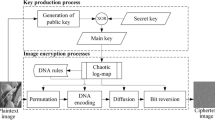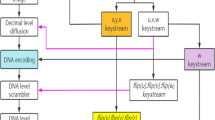Abstract
In this paper, a hybrid security solution based on the chaotic map for a discrete cosine transform (DCT) precoded orthogonal frequency division multiplexing (OFDM) system is proposed. The two-level encryption scheme is employed to encrypt the image in the upper and physical layer of the OFDM system. At first, bit-level encryption based on Deoxyribo Nucleic Acid coding and combined chaotic map is done in the upper layer of the proposed system. Then, the encrypted bitstreams are fed to the OFDM transmitter where the real and imaginary parts of the quadrature amplitude modulated symbols are scrambled chaotically to achieve the symbol level encryption in the physical layer of OFDM system. In addition to the hybrid security model, DCT precoding is added to achieve the trade-off between bit error rate (BER) and peak to average power ratio (PAPR) performance. Experiments are carried out to validate the strength of encryption algorithms against key sensitivity, statistical and differential attacks. Further, the BER, PAPR and peak signal to noise ratio performances have been analyzed for various cases to prove the strength of the proposed system to achieve enhanced security with better power and BER performance.










Similar content being viewed by others
Data availability
All data generated or analysed during this study are included in this published article.
References
Hamamreh, J. M., Furqan, H. M., & Arslan, H. (2019). Classifications and applications of physical layer security techniques for confidentiality: A comprehensive survey. IEEE Communications Surveys and Tutorials. https://doi.org/10.1109/COMST.2018.2878035
Zou, Y., Zhu, J., Wang, X., & Hanzo, L. (2016). A survey on wireless security: Technical challenges, recent advances, and future trends. Proceedings of the IEEE. https://doi.org/10.1109/JPROC.2016.2558521
Melki, R., Noura, H. N., Mansour, M. M., & Chehab, A. (2019). A survey on OFDM physical layer security. Physical Communication. https://doi.org/10.1016/j.phycom.2018.10.008
Peng, L., Li, G., Zhang, J., Woods, R., Liu, M., & Hu, A. (2019). An investigation of using loop-back mechanism for channel reciprocity enhancement in secret key generation. IEEE Transactions on Mobile Computing. https://doi.org/10.1109/TMC.2018.2842215
Xu, D., Ren, P., & Ritcey, J. A. (2018). Independence-checking coding for OFDM channel training authentication: Protocol design, security, stability, and tradeoff analysis. IEEE Transactions on Information Forensics and Security. https://doi.org/10.1109/TIFS.2018.2850334
Wu, X., Yang, Z., Ling, C., & Xia, X. G. (2016). Artificial-noise-aided physical layer phase challenge-response authentication for practical OFDM transmission. IEEE Transactions on Wireless Communications. https://doi.org/10.1109/TWC.2016.2586472
Lu, X., Shi, Y., Li, W., Lei, J., & Pan, Z. (2019). A joint physical layer encryption and PAPR reduction scheme based on polar codes and chaotic sequences in OFDM system. IEEE Access. https://doi.org/10.1109/ACCESS.2019.2919598
Ma, R., Dai, L., Wang, Z., & Wang, J. (2010). Secure communication in TDS-OFDM system using constellation rotation and noise insertion. IEEE Transactions on Consumer Electronics. https://doi.org/10.1109/TCE.2010.5606266
Li, W., McLernon, D., Wong, K. K., Wang, S., Lei, J., & Zaidi, S. A. R. (2019). Asymmetric physical layer encryption for wireless communications. IEEE Access. https://doi.org/10.1109/ACCESS.2019.2909298
Zhang, J., Marshall, A., Woods, R., & Duong, T. Q. (2017). Design of an OFDM physical layer encryption scheme. IEEE Transactions on Vehicular Technology. https://doi.org/10.1109/TVT.2016.2571264
Rahmatallah, Y., & Mohan, S. (2013). Peak-to-average power ratio reduction in ofdm systems: A survey and taxonomy. IEEE Communications Surveys and Tutorials. https://doi.org/10.1109/SURV.2013.021313.00164
Aburakhia, S. A., Badran, E. F., & Mohamed, D. A. E. (2009). Linear companding transform for the reduction of peak-to-average power ratio of OFDM signals. IEEE Transactions on Broadcasting. https://doi.org/10.1109/TBC.2009.2013987
Wang, Y., Ge, J., Wang, L., Li, J., & Ai, B. (2013). Non-linear companding transform for reduction of peak-to-average power ratio in OFDM systems. IEEE Transactions on Broadcasting. https://doi.org/10.1109/TBC.2012.2219252
Slimane, S. B. (2007). Reducing the peak-to-average power ratio of OFDM signals through precoding. IEEE Transactions on Vehicular Technology. https://doi.org/10.1109/TVT.2007.891409
Wang, Y. C., & Luo, Z. Q. (2011). Optimized iterative clipping and filtering for PAPR reduction of OFDM signals. IEEE Transactions on Communications. https://doi.org/10.1109/TCOMM.2010.102910.090040
Lawrey, E., & Kikkert, C. J. (1999). Peak to average power ratio reduction of OFDM signals using peak reduction carriers. In ISSPA 1999 - proceedings of the 5th international symposium on signal processing and its applications. https://doi.org/10.1109/ISSPA.1999.815777
Wang, Z., Chen, F., Qiu, W., Chen, S., & Ren, D. (2018). A two layer chaotic encryption scheme of secure image transmission for DCT precoded OFDM-VLC transmission. Optics Communications. https://doi.org/10.1016/j.optcom.2017.09.095
Sung, M., Lee, J., & Jeong, J. (2013). DCT-precoding technique in optical fast OFDM for mitigating fiber nonlinearity. IEEE Photonics Technology Letters. https://doi.org/10.1109/LPT.2013.2283292
Alvarez, G., & Li, S. (2006). Some basic cryptographic requirements for chaos-based cryptosystems. International Journal of Bifurcation and Chaos, 16(08), 2129–2151. https://doi.org/10.1142/S0218127406015970
Ravichandran, D., Praveenkumar, P., Balaguru Rayappan, J. B., & Amirtharajan, R. (2016). Chaos based crossover and mutation for securing DICOM image. Computers in Biology and Medicine, 72, 170–184. https://doi.org/10.1016/j.compbiomed.2016.03.020
Ravichandran, D., Praveenkumar, P., Rayappan, J. B. B., & Amirtharajan, R. (2017). DNA chaos blend to secure medical privacy. IEEE Transactions on Nanobioscience, 16(8), 850–858. https://doi.org/10.1109/TNB.2017.2780881
Ravichandran, D., Rajagopalan, S., Upadhyay, H. N., Rayappan, J. B. B., & Amirtharajan, R. (2018). Encrypted biography of biomedical image - a pentalayer cryptosystem on FPGA. Journal of Signal Processing Systems. https://doi.org/10.1007/s11265-018-1337-z
Dhivya, R., Padmapriya, V., Sundararaman, R., Rayappan, J. B. B., & Amirtharajan, R. (2018). Chaos assisted variable bit steganography in transform domain. Electronics Letters, 54(23), 1332–1334. https://doi.org/10.1049/el.2018.6426
Hu, X., Yang, X., Shen, Z., He, H., Hu, W., & Bai, C. (2015). Chaos-based partial transmit sequence technique for physical layer security in OFDM-PON. IEEE Photonics Technology Letters. https://doi.org/10.1109/LPT.2015.2466092
Liu, B., Zhang, L., Xin, X., & Wang, Y. (2014). Physical layer security in OFDM-PON based on dimension-transformed chaotic permutation. IEEE Photonics Technology Letters, 26(2), 127–130. https://doi.org/10.1109/LPT.2013.2290041
Zhang, L., Xin, X., Liu, B., & Wang, Y. (2011). Secure OFDM-PON based on chaos scrambling. IEEE Photonics Technology Letters. https://doi.org/10.1109/LPT.2011.2149512
Wu, T., Zhang, C., Wei, H., & Qiu, K. (2019). PAPR and security in OFDM-PON via optimum block dividing with dynamic key and 2D-LASM. Optics Express, 27(20), 27946. https://doi.org/10.1364/OE.27.027946
Wei, H., Zhang, C., Wu, T., Huang, H., & Qiu, K. (2019). Chaotic multilevel separated encryption for security enhancement of OFDM-PON. IEEE Access, 7, 124452–124460. https://doi.org/10.1109/ACCESS.2019.2938910
Wu, T., Zhang, C., Chen, C., Hou, H., Wei, H., Hu, S., & Qiu, K. (2018). Security enhancement for OFDM-PON using Brownian motion and chaos in cell. Optics Express, 26(18), 22857. https://doi.org/10.1364/OE.26.022857
Panta, K. R., & Armstrong, J. (2004). Effects of clipping on the error performance of OFDM in frequency selective fading channels. IEEE Transactions on Wireless Communications. https://doi.org/10.1109/TWC.2003.821142
Funding
The authors wish to express their sincere thanks to the INSPIRE Fellowship (No. DST/INSPIRE Fellowship/2015/IF150628), Department of Science and Technology (DST), India, for their financial support and FIST funding (SR/FST/ET-II/2018/221).
Author information
Authors and Affiliations
Corresponding author
Ethics declarations
Conflict of interest
The authors do not have conflicts of interest associated with this publication.
Ethical approval
This article does not contain any studies with human participants or animals performed by any authors.
Additional information
Publisher's Note
Springer Nature remains neutral with regard to jurisdictional claims in published maps and institutional affiliations.
Rights and permissions
Springer Nature or its licensor (e.g. a society or other partner) holds exclusive rights to this article under a publishing agreement with the author(s) or other rightsholder(s); author self-archiving of the accepted manuscript version of this article is solely governed by the terms of such publishing agreement and applicable law.
About this article
Cite this article
Ravichandran, D., Padmaa, M., Rajagopal, N. et al. Chaos and DNA Blended Hybrid Encryption Algorithm for Secure Image Transmission over DCT Pre-coded OFDM. Wireless Pers Commun 129, 703–727 (2023). https://doi.org/10.1007/s11277-022-10152-y
Accepted:
Published:
Issue Date:
DOI: https://doi.org/10.1007/s11277-022-10152-y




